
Orchids are plants that belong to the family Orchidaceae, a diverse and widespread group of flowering plants with blooms that are often colourful and fragrant. Orchids are cosmopolitan plants that are found in almost every habitat on Earth except glaciers. The world's richest diversity of orchid genera and species is found in the tropics.

Bulbophyllum is a genus of mostly epiphytic and lithophytic orchids in the family Orchidaceae. It is the largest genus in the orchid family and one of the largest genera of flowering plants with more than 2,000 species, exceeded in number only by Astragalus. These orchids are found in diverse habitats throughout most of the warmer parts of the world including Africa, southern Asia, Latin America, the West Indies, and various islands in the Indian and Pacific Oceans. Orchids in this genus have thread-like or fibrous roots that creep over the surface of trees or rocks or hang from branches. The stem is divided into a rhizome and a pseudobulb, a feature that distinguished this genus from Dendrobium. There is usually only a single leaf at the top of the pseudobulb and from one to many flowers are arranged along an unbranched flowering stem that arises from the base of the pseudobulb. Several attempts have been made to separate Bulbophyllum into smaller genera, but most have not been accepted by the World Checklist of Selected Plant Families.

The Pleurothallidinae are a neotropical subtribe of plants of the orchid family (Orchidaceae) including 29 genera in more than 4000 species.

Cypripedioideae is a subfamily of orchids commonly known as lady's slipper orchids, lady slipper orchids or slipper orchids. Cypripedioideae includes the genera Cypripedium, Mexipedium, Paphiopedilum, Phragmipedium and Selenipedium. They are characterised by the slipper-shaped pouches of the flowers – the pouch traps insects so they are forced to climb up past the staminode, behind which they collect or deposit pollinia, thus fertilizing the flower. There are approximately 165 species in the subfamily.

Oncidium, abbreviated as Onc. in the horticultural trade, is a genus that, as of December 2023, contains about 340 species of orchids from the subtribe Oncidiinae of the orchid family Orchidaceae. It is distributed across tropical and subtropical America from Mexico, Central America and the West Indies to northern Argentina, with one species (O. ensatum) extending into Florida. Common names for plants in this genus include dancing-lady orchid and golden shower orchid.

The taxonomy of the Orchidaceae (orchid family) has evolved slowly during the last 250 years, starting with Carl Linnaeus who in 1753 recognized eight genera. De Jussieu recognized the Orchidaceae as a separate family in his Genera Plantarum in 1789. Olof Swartz recognized 25 genera in 1800. Louis Claude Richard provided us in 1817 with the descriptive terminology of the orchids. (See External links below). The next step was taken in 1830-1840 by John Lindley, who recognized four subfamilies. He is generally recognized as the father of orchid taxonomy. The next important step was taken by George Bentham with a new classification, recognizing subtribes for the first time. This classification was first presented in a paper that Bentham read to the Royal Society in 1881. Then it was published in 1883 in the final volume of Genera Plantarum. The next great contributors were Pfitzer (1887), Schlechter (1926), Mansfeld (1937), Dressler and Dodson (1960), Garay (1960, 1972), Vermeulen (1966), again Dressler (1981). and Burns-Balogh and Funk (1986). Dressler's 1993 book had considerable influence on later work.
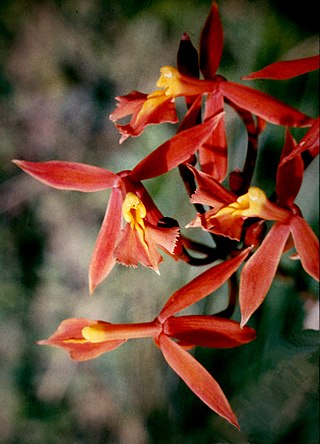
Epidendroideae is a subfamily of plants in the orchid family, Orchidaceae. Epidendroideae is larger than all the other orchid subfamilies together, comprising more than 15,000 species in 576 genera. Most epidendroid orchids are tropical epiphytes, typically with pseudobulbs. There are, however, some terrestrials such as Epipactis and even a few myco-heterotrophs, which are parasitic upon mycorrhizal fungi.
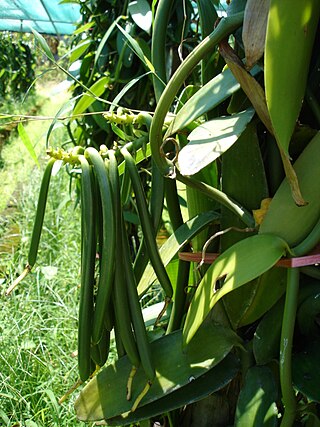
Vanilloideae is one of the subfamilies of orchids belonging to the large family Orchidaceae.

The Galápagos Islands xeric scrub, also known as the Galápagos Islands scrubland mosaic, is a terrestrial deserts and xeric shrublands ecoregion that covers the Galápagos Islands. The Galápagos Islands are volcanic in origin, and remote from continents and other islands. The ecoregion is well known for its unique endemic species, including giant tortoises, birds, and marine iguanas, which evolved in isolation to adapt to islands' environments.

Maxillaria, abbreviated as Max in the horticultural trade, is a large genus of orchids. This is a diverse genus, with very different morphological forms. Their characteristics can vary widely. They are commonly called spider orchids, flame orchids or tiger orchids. Their scientific name is derived from the Latin word maxilla, meaning jawbone, reflecting on the column and the base of the lip of some species, that may evoke a protruding jaw.

Caladenia, commonly known as spider orchids, is a genus of 350 species of plants in the orchid family, Orchidaceae. Spider orchids are terrestrial herbs with a single hairy leaf and a hairy stem. The labellum is fringed or toothed in most species and there are small projections called calli on the labellum. The flowers have adaptations to attract particular species of insects for pollination. The genus is divided into three groups on the basis of flower shape, broadly, spider orchids, zebra orchids and cowslip orchids, although other common names are often used. Although they occur in other countries, most are Australian and 136 species occur in Western Australia, making it the most species-rich orchid genus in that state.
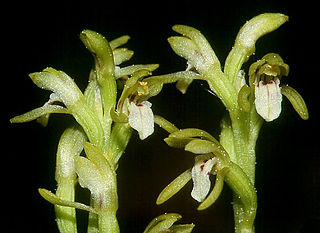
Corallorhiza, the coralroot, is a genus of flowering plants in the orchid family. Except for the circumboreal C. trifida, the genus is restricted to North America.

Moehringia is a genus of flowering plants in the family Caryophyllaceae. Members of this genus and of some other genera in Caryophyllaceae are commonly called sandworts. They are found only in the north temperate zone. The genus Moehringia was first formally named by Carl Linnaeus in 1753. It is named after the German naturalist Paul Möhring (1710–1792).

Comparettia, abbreviated Comp in the horticultural trade, is a genus of orchids. It consists about 50-70 species, native to tropical America. They occur in Mexico, Central America, the West Indies, and in northern South America as far south as Brazil and Bolivia, although they are particularly common in the Andes. The genus has grown markedly in recent years due to many species being transferred from other genera.

Psychopsis is a genus of four known species of orchids native to northern South America, Central America and Trinidad. The genus name is abbreviated Pyp. in the horticultural trade.
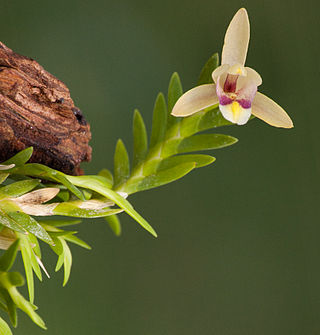
The Vandeae is a large monophyletic tribe within the family of orchids.

Cuitlauzina is a genus of flowering plants from the orchid family, Orchidaceae. It contains 8 recognized species, native to Mexico, Central America and Colombia.
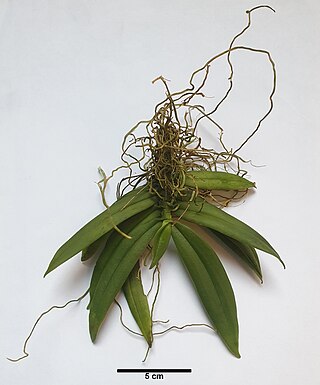
Grosourdya is a genus of flowering plants from the orchid family, Orchidaceae. As of May 2022, it contains 26 known species, native to Southeast Asia.
- Grosourdya appendiculata(Blume) Rchb.f. - widespread from Hainan to the Andaman Islands to the Philippines and Maluku
- Grosourdya bicornutaJ.J.Wood & A.L.Lamb - Sabah
- Grosourdya bigibba (Schltr.) Kocyan & Schuit.
- Grosourdya calliferaSeidenf. - Thailand
- Grosourdya ciliata (Ridl.) Kocyan & Schuit.
- Grosourdya decipiens (J.J.Sm.) Kocyan & Schuit.
- Grosourdya emarginata (Blume) Rchb.f.
- Grosourdya fasciculata (Carr) Kocyan & Schuit.
- Grosourdya incurvicalcar(J.J.Sm.) Garay - Java, Peninsular Malaysia, Sulawesi
- Grosourdya leytensis (Ames) Kocyan & Schuit.
- Grosourdya lobata Kocyan & Schuit.
- Grosourdya milneri P.O'Byrne, Gokusing & J.J.Wood
- Grosourdya mindanaensis (Ames) Kocyan & Schuit.
- Grosourdya minutiflora(Ridl.) Garay - Pahang
- Grosourdya minutissima P.T.Ong & P.O'Byrne
- Grosourdya multistrata P.O'Byrne, J.J.Verm. & S.M.L.Lee
- Grosourdya muscosa(Rolfe) Garay - Peninsular Malaysia, Thailand, Andaman Islands
- Grosourdya myosurus (Ridl.) Kocyan & Schuit.
- Grosourdya nitida (Seidenf.) Kocyan & Schuit.
- Grosourdya pulvinifera(Schltr.) Garay - Sabah, Sulawesi
- Grosourdya quinquelobata(Schltr.) Garay - Sulawesi
- Grosourdya reflexicalcarP.O'Byrne & J.J.Verm.
- Grosourdya tripercus(Ames) Garay - Leyte
- Grosourdya urunensisJ.J.Wood, C.L.Chan & A.L.Lamb - Sabah
- Grosourdya vietnamica (Aver.) Kumar & S.W.Gale
- Grosourdya zollingeri(Rchb.f.) Rchb.f. - Java, Maluku

Dendrobieae is a tribe in the subfamily Epidendroideae, in the family Orchidaceae. The Dendrobieae are mostly tropical, epiphytic orchids which contain pseudobulbs.
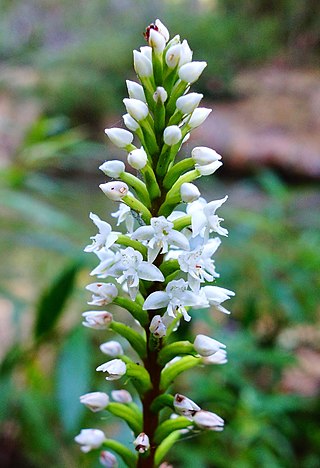
Cranichis muscosa, the cypress-knee helmet orchid, is a species of terrestrial orchid. It is widespread across most of the West Indies, extending into Central America, southern Mexico, Belize, northern South America, and southern Florida.




















